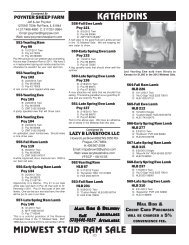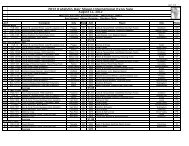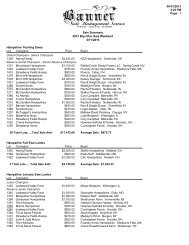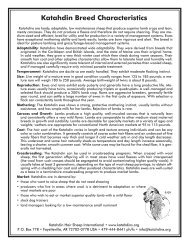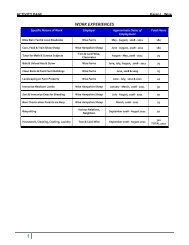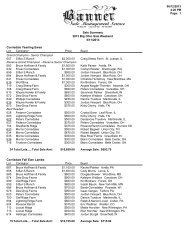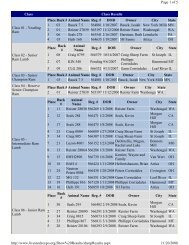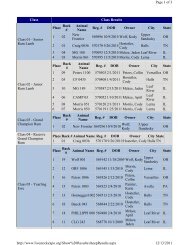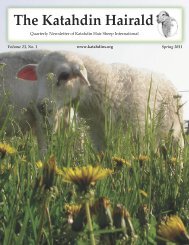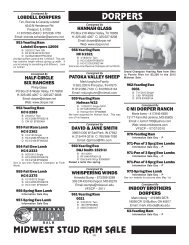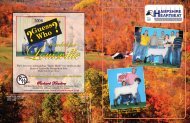You also want an ePaper? Increase the reach of your titles
YUMPU automatically turns print PDFs into web optimized ePapers that Google loves.
<strong>History</strong> <strong>of</strong> <strong>the</strong> <strong>Katahdin</strong> <strong>Breed</strong><strong>Katahdin</strong> sheep are a breed <strong>of</strong> hair sheep developed in <strong>the</strong> United States, a small but growing element<strong>of</strong> <strong>the</strong> sheep industry in North America. There are 100 million hair sheep around <strong>the</strong> world—10%<strong>of</strong> <strong>the</strong> world’s sheep population—<strong>of</strong> which 90% are in Africa and 10% are in Latin America and <strong>the</strong>Caribbean. The <strong>Katahdin</strong> breed originated at <strong>the</strong> Piel Farm in north central Maine where Michael Pielwas an innovator and “amateur geneticist” who enjoyed raising livestock. His first intentions related toestablishing a sheep enterprise were to use sheep to graze power lines instead <strong>of</strong> spraying or mowing<strong>the</strong> vegetation. He <strong>the</strong>n developed o<strong>the</strong>r ideas on how to employ sheep for land management.Barbara Piel wrote: “From <strong>the</strong> time Michael was in high school and had a small flock <strong>of</strong> Suffolks, hewas fascinated by sheep, <strong>the</strong>ir history and management. When he moved to Maine after World War II,he raised Corriedales and Columbias, but <strong>the</strong> market for wool set him thinking about a meat sheep thatwouldn’t need shearing. If <strong>the</strong> grower wanted to concentrate on <strong>the</strong> lamb market, he had no choice butto grow wool as well; so he began research and correspondence to firm up his ideas on how to producea meat sheep.”In 1956 and 1957, Piel began making inquiries about hair sheep after seeing pictures in a NationalGeographic magazine <strong>of</strong> West African hair sheep. He eventually made contact with Richard Bond <strong>of</strong> <strong>the</strong>U.S. Agricultural Research Service in St. Croix, Virgin Islands who was working with hair sheep flockson <strong>the</strong> island.Piel imported “African Hair Sheep,” as <strong>the</strong>y were called <strong>the</strong>n, to Maine from St. Croix in November1957. All were less than a year <strong>of</strong> age, born triplets, unrelated for many generations, and woolless withwoolless siblings. One female was tan in color, <strong>the</strong> o<strong>the</strong>rs were white.The ram lamb, “King Tut,” was used for breeding a handful <strong>of</strong> ewes in December 1957, including Tunis,Southdown, Hampshire, Suffolk, and <strong>the</strong> “African” ewe lambs. From this point on, crosses <strong>of</strong> manybreed combinations (including Cheviots and o<strong>the</strong>r “Down” breeds), were made as Piel tried to determinewhat would create <strong>the</strong> type <strong>of</strong> ewe he was looking for. He was particularly selecting for hair coat,meat-type conformation, high fertility, and flocking instinct.Excerpts from a Piel letter dated December 28, 1965:“This season I kept about 120 part-African ewe lambs, so I now have at least 200 part-African ewes.I bred quite a few <strong>of</strong> <strong>the</strong>m to my old, original African ram, “King Tut” in order to get a bunch <strong>of</strong> 3/4-breds. I bred ano<strong>the</strong>r big bunch to ano<strong>the</strong>r yearling ram which I had selected because <strong>of</strong> improvedconformation as well as relative woollessness. This ram was part-African and part-Suffolk. The restwere bred to miscellaneous part-African ram lambs in hopes that <strong>the</strong> law <strong>of</strong> chance would shake up<strong>the</strong> genes a little bit.I noticed this fall that I now have three or four part-African ewes that are quite a lot better than average.One is almost pure hair, with just a patch <strong>of</strong> wool on top <strong>of</strong> <strong>the</strong> shoulders and a little bit on <strong>the</strong>gaskin area. Her conformation is really quite good, I think. It is my hope that I will soon get enough<strong>of</strong> such outstanding individuals to be able to start a “family” to select from. Then I can cull back <strong>the</strong>flock drastically and start from scratch.”In 1963, a pure African Hair ram lamb was provided to John Glenn at Louisiana State University touse in crossbreeding trials with “Louisiana Natives,” a local landrace type <strong>of</strong> wool sheep that was extremelyhardy and adapted to <strong>the</strong> hot, humid climate. Dr. Glenn saw a great deal <strong>of</strong> potential in <strong>the</strong>crosses and <strong>of</strong>fered a 1⁄4-blood Native ram to Piel to reduce inbreeding pressure (though this did notmaterialize). However, <strong>the</strong> promising crossbreeding program was dropped abruptly in1967 when Glenn left LSU, and his supervisor was more inclined to use Suffolks to9/09improve carcass quality.John Glenn wrote to Michael Piel January 17, 1966:“We have never had any difficulty with low fertility from <strong>the</strong> African Hair ramsor <strong>the</strong> crossbred ewes when breeding in April and May, or in fact, in any <strong>of</strong> <strong>the</strong>seasons. Almost all <strong>of</strong> our African Hair-cross ewes bred at <strong>the</strong> first period in Apriland produced lambs in September and October. I feel that this possibility <strong>of</strong> producinglambs throughout <strong>the</strong> year, as well as providing sheep that would not have to be<strong>Katahdin</strong> Hair Sheep International • www.katahdins.orgP. O. Box 778 • Fayetteville, AR 72702-0778 USA • 479-444-8441 ph/fx • info@katahdins.org
<strong>History</strong> <strong>of</strong> <strong>the</strong> <strong>Katahdin</strong> <strong>Breed</strong> (cont’d.)sheared, which many <strong>of</strong> our producers consider a disadvantage since shearers are very difficult toobtain here, might encourage some <strong>of</strong> <strong>the</strong> local livestock men to obtain a flock <strong>of</strong> sheep along with<strong>the</strong>ir beef cattle operation. In fact, I <strong>of</strong>ten think that this is <strong>the</strong> only possibility <strong>of</strong> establishing a sheepindustry in Louisiana within <strong>the</strong> near future at least.”Michael Piel wrote back in January 22, 1966:“It occurs to me that it would not be completely out <strong>of</strong> <strong>the</strong> question for an Agricultural College suchas yours to obtain a financial grant from some such outfit as <strong>the</strong> DuPont people to pursue <strong>the</strong> development<strong>of</strong> a wool-lessbreed <strong>of</strong> sheep. After all, <strong>the</strong>y are largely responsible for ruining <strong>the</strong> wool business, and it would onlybe to <strong>the</strong>ir advantage (for public relations) to demonstrate that sheep production could be pr<strong>of</strong>itablewithout wool production.”In <strong>the</strong> early 1970s, Piel felt he had come close to his goal <strong>of</strong> a “meat sheep that did not require shearing.”He selected from his large flock approximately 120 <strong>of</strong> <strong>the</strong> best ewes and called <strong>the</strong>m “<strong>Katahdin</strong>”sheep after Mt. <strong>Katahdin</strong>, <strong>the</strong> highest peak in <strong>the</strong> state <strong>of</strong> Maine.In October 1975, Piel imported a handful <strong>of</strong> Wiltshire Horn sheep from Wales via Canada. He intendedto improve size and bone by incorporating <strong>the</strong> Wiltshire into <strong>the</strong> <strong>Katahdin</strong>s. The first crosseswere born in 1976.Paul and Margaret Jepson <strong>of</strong> Vermont had become acquainted with Piel while trying to locate WiltshireHorn stock and decided <strong>the</strong> newly developed <strong>Katahdin</strong>s would suit <strong>the</strong>m better. They purchased somesheep from Piel in <strong>the</strong> mid-1970s and established <strong>the</strong> first satellite flock <strong>of</strong> <strong>Katahdin</strong>s. The Jepsons <strong>the</strong>nexperimented with incorporating St. Croix blood (ano<strong>the</strong>r hair sheep breed akin to <strong>the</strong> original “AfricanHair” type) into <strong>the</strong>ir flock in <strong>the</strong> early 1980s.Michael Piel died suddenly <strong>of</strong> a heart attack in December <strong>of</strong> 1976. The Wiltshire Horn influence in <strong>the</strong>Piel Farm flock increased in <strong>the</strong> late 1970s as scale and bone improved somewhat. However, <strong>the</strong> undesirablepresence <strong>of</strong> horns, decreased prolificacy and flocking instinct, and a flightier disposition resultedfrom incorporating <strong>the</strong> Wiltshire Horn. During <strong>the</strong> early 1980s, under <strong>the</strong> leadership <strong>of</strong> Barbara Piel andfarm manager Charles Brown, flock selection was against horns, thus diminishing <strong>the</strong> Wiltshire geneticinfluence on <strong>the</strong> <strong>Katahdin</strong> breed and streng<strong>the</strong>ning maternal traits once again.Heifer Project International, an international livestock development charity, took an interest in Piel’swork and his “improved” hair sheep. Piel accompanied an HPI-sponsored shipment <strong>of</strong> his sheep toGuatemala in February 1976 and was caught in a devastating earthquake <strong>the</strong>re just after <strong>the</strong> planelanded—a very stressful experience for him! HPI realized that <strong>Katahdin</strong>s were well-suited to <strong>the</strong> sou<strong>the</strong>rnU.S. and built a sizeable flock at <strong>the</strong>ir center in Arkansas through <strong>the</strong> 1980s based on stock fromPiel Farm and Jepsons.<strong>Katahdin</strong> Hair Sheep International was incorporated in 1985 as a breeders’ association and registry byPiel Farm, Heifer Project, and Donald Williams. The first inspection <strong>of</strong> animals for <strong>the</strong> original registryflock book was conducted in 1986 by Stan Musgrave, an animal scientist from Maine familiar with <strong>the</strong>Piel flock. The first KHSI members were accepted in 1987, and twenty-three breeders agreed to joinKHSI and register <strong>the</strong>ir <strong>Katahdin</strong> stock.Interest and enthusiasm for <strong>the</strong> breed has developed steadily since those early days. Over 20 yearslater, at <strong>the</strong> end <strong>of</strong> 2008, KHSI has registered and recorded over 75000 animals and has had a membershipaveraging 500 members throughout North America since 2000. Since 2001,KHSI has been in <strong>the</strong> top 6 registries in <strong>the</strong> USA in terms <strong>of</strong> number <strong>of</strong> animals registeredper year. Mandatory inspection <strong>of</strong> registered <strong>Katahdin</strong>s continued through9/091998, streng<strong>the</strong>ning predictability <strong>of</strong> hair coat and standard <strong>of</strong> type. Commercialflocks <strong>of</strong> <strong>Katahdin</strong> and <strong>Katahdin</strong>-cross ewes have become more popular for efficient,low-input meat lamb production. Hundreds <strong>of</strong> <strong>Katahdin</strong>s have been exported toCentral and South America, <strong>the</strong> Caribbean, Sou<strong>the</strong>ast Asia and <strong>the</strong> United Kingdom.The <strong>Katahdin</strong> breed has proven to be adaptable, easy to manage and efficient—nowonder it is a “breed whose time has come.”<strong>Katahdin</strong> Hair Sheep International • www.katahdins.orgP. O. Box 778 • Fayetteville, AR 72702-0778 USA • 479-444-8441 ph/fx • info@katahdins.org



